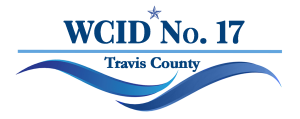I received a notice for violating water restrictions. What should I do?
– WCID No. 17 is enforcing the Stage 2 water restrictions as required by the LCRA and set forth in our Drought Contingency Plan. If you have received a violation notice, please visit our website at https://www.wcid17.org/water-restrictions-and-conservation/ to ensure you are watering on your designated day. We suggest you do this as soon as possible in order to avoid being fined and potentially even have service disconnected.
– Check your irrigation controller to ensure it is set properly. We have found many customers were watering correctly with one program on their irrigation controller but inadvertently also had a second program running. Also, remember to check the irrigation controller after a power outage as they tend to reset to factory settings.
– Check for leaks! A running toilet can waste up to 200 gallons a day. If you suspect a leak, please call our office at 512.266.1111 so we can review your account with you.
– View your water consumption and monitor water use by downloading the “My Water Advisor 2.0” app or visit https://mywateradvisor2.com/ to sign up. You will then be able to access your own data and even be notified if you should ever have a leak.
– Pay your fine as soon as possible by visiting our office at 3812 Eck Ln. or call our office at 512.266.1111. Please note, due to heavy call volume, it could take up to 72 hours to return your call.
– It is up to each customer to stay informed on the current water restrictions. You may do so by visiting our website at https://www.wcid17.org/water-restrictions-and-conservation/ or our Facebook page at https://www.facebook.com/WCIDNo.17
Why are you issuing fines for violating water restrictions?
– WCID No. 17 adopted a new Drought Contingency Plan in order to help safeguard the water supply for our 50,000 customers. The ongoing drought, record-low inflows into Lakes Travis and Buchanan as well as community growth have made it necessary to conserve our water supply so that we can have water to drink, bathe and use in our homes.
How do you determine which stage we are in?
– Outlined in the new Drought Contingency Plan, the stage of watering restriction is based on the acre-feet of combined storage rather than the current level of the lake.
I was issued a violation but I’m only watering on the wrong days. Why is this even a restriction?
– Some customers may wonder why watering on the wrong day is a violation since they aren’t over watering or even watering outside the allotted times. If just 25% of the District’s customers are watering on the wrong days, it could amount to a little more than 5.6 million gallons of unplanned water use. This, on top of normal daily use, would significantly impact the District’s ability to serve all of our customers as there is a limit to how much water our treatment plants can provide on a given day.
Are commercial accounts and HOAs held to the same restrictions?
– Yes, both commercial accounts and HOAs are only able to water on Fridays unless they have an effluent water account meaning they use reclaimed water to irrigate. Customers who use reclaimed water should irrigate during cooler parts of the day.
Can my fine be waived?
– Unfortunately, our customer service representatives are not able to waive fines for customers who violate water restrictions. We take water conservation seriously and would encourage our entire community to do so as well.
Where does the money from fining customers go?
– All fines are treated as revenue and are used to help support programs like our water conservation credit.
Can I get on a variance list for filling my newly-constructed pool?
– Draining and re-filling a pool is permitted only onto pervious surfaces or onto a surface where water will be transmitted directly to a pervious surface, and only if: Draining excess water from pool due to rain or in order to lower water to maintenance level; Repairing, maintaining or replacing pool components that have become hazardous; or Repair of a pool leak.
– Pool-owners can get on a variance list by completing the form on our website at https://www.wcid17.org/forms/
What about installing new landscapes/planting sod?
New landscapes may be installed and re-vegetation seeding performed under these specific criteria: 1. A completed variance form for new landscapes has been submitted to the District and has been approved prior to the installation of the landscape, or re-vegetation seed application 2. Irrigation of the new landscape follows the schedule identified in the new landscape variance. The schedule will be developed to minimize water waste. 3. Areas being re-vegetated for soil stabilization must also comply with the (1) and (2) specific criteria above. Alternative options to re-vegetation such as mulch may be available in times of low water supply. Specific information regarding options is available in the LCRA Highland Lakes Watershed Ordinance Technical Manual. 4. Variances for new landscapes may be issued for a period of no more than 30 days from the day of issuance. A variance is not an exemption from Drought Contingency Plan Page 10 compliance with the permanent water use restrictions under Section 9.2 of this plan. Variances will not be granted for seasonal “color bed” or temporary grass installation (overseeding).
According to my Homeowners Association (HOA) guidelines, I am required to maintain a well-landscaped and green lawn. However, due to the restrictions in place during Stage 2, I am unable to meet the requirement at this time.
WCID No. 17 informs HOAs about water restrictions and encourages them to not enforce green lawn requirements for homeowners. If your HOA is enforcing restrictions, please let us know so we can reach out to them.



